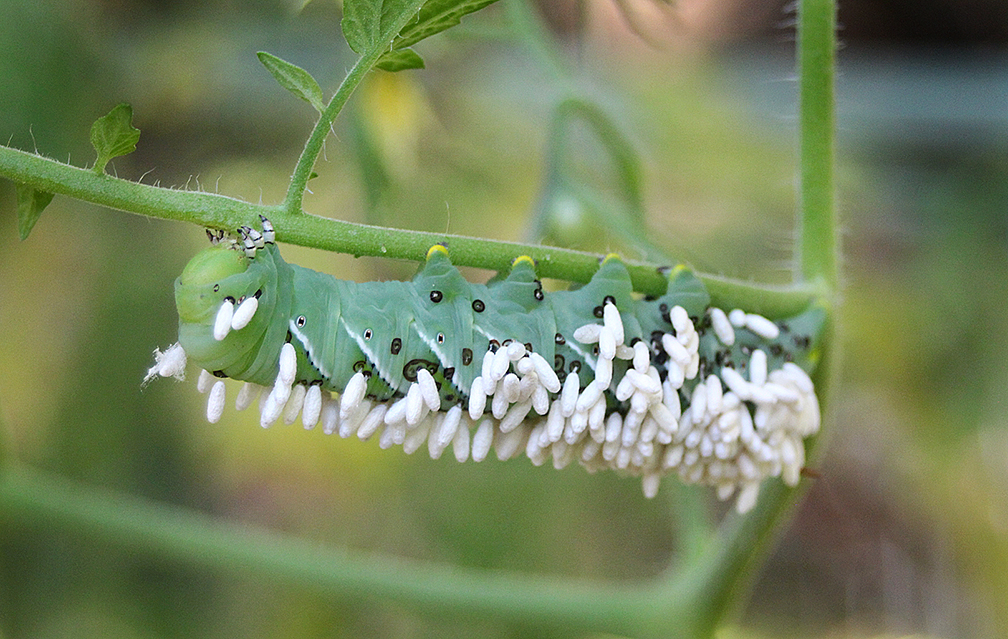Something In The Garden

PHOTO: A tomato hornworm is covered in braconid wasp larvae on a tomato plant in New England last week.

by Chris Bosak
Weirs Times Columnist
I was all set to follow last week’s column about fall migration with a closer look at some of the songbirds, including warblers, that are heading south now and will be for the next several weeks.
That column has been put on hold as I saw something in the garden last week that just can’t wait. Experienced vegetable gardeners have likely seen this before, but it was a first for me and I was amazed at the gruesome details when I researched it online.
First, a little background. It is a first-year garden plot. I dug it during April at the height of the COVID-19 outbreak in the Northeast. More than anything else, it was a diversion from the nuttiness going on in the world; something to keep my mind and body occupied during quarantine. I’ve never had a green thumb and I had little hope in the garden ever yielding impressive crops.
As it turns out, my pessimism was warranted. Once the leaves popped on the giant oaks that surround my property, the garden didn’t stand a chance. Tomato plants require how much sunlight? Oh boy, not even close. It was like that Rush song where the maples complain that the “oaks are just too lofty, and they grab up all the light.”
Fast forward to early September. I got a few tomatoes (emphasis on few), three jalapeño peppers and a few dozen beans. The sighting the other day made up for the meager vegetable yield, however. I approached the garden after not bothering to check it for a few days and noticed a strange white growth on one of the tomato plants.
Upon closer inspection, the growth seemed to be a clump of egg-like ovals. Then the clump moved, ever so slightly. I was about to rip off the branch when I noticed the white “eggs” (there were hundreds of them) were attached to a large, green caterpillar. My first inclination was to knock the white things off the caterpillar, but I wanted to research it first.
Years ago, I would have had to wait until the library opened the next day and spend a few hours thumbing through encyclopedias to find out. Instead, I pulled the phone out of my pocket, launched the internet and had the answer in about nine seconds.
The answer is the stuff horror movies are made of. The “eggs” weren’t eggs at all, but the larval stage of the braconid wasp. The actual eggs were laid inside the caterpillar by an adult female wasp. Once hatched, the larvae literally ate their way out of the caterpillar and spun a white cocoon attached to the outside of the caterpillar.
The garden blogs and websites say this is a good thing as the braconid wasps are harmless to humans and the caterpillar is a tomato hornworm, which they say can devour an entire tomato plant in a single day. The tomato hornworm, however, would eventually turn into a hawk moth, otherwise known as a sphynx or hummingbird moth, which is always a thrill to see around flowers in late summer. Plus, they are really cool-looking caterpillars with large, bright green bodies and a “horn” on the back end.
There’s really no choice for us to make anyway. It’s in nature’s hands. By the time the caterpillar is covered in tiny cocoons, the larva of the parasitic wasps have already eaten their way through the insides of the caterpillar. I’m not an entomologist by any stretch, but I would imagine the caterpillar is a goner by that point anyway. Knocking the cocoons off won’t save it at this point. The caterpillar is still alive, but I can’t fathom it being healthy enough to go through a metamorphosis.
Something I saw in the garden supported my amateur theory. I watched the drama unfold in the garden for a while. I photographed it from all angles, of course. Then I looked at my tomato plants for more hornworms, infested or not, and sure enough, there was another one on a higher branch of the adjacent plant. This hornworm was in much worse shape. While the original one still otherwise looked like a robust caterpillar, the second one I found was decimated. It, too, was still alive, but barely.
It’s a scene that plays itself out in gardens across our region on a regular basis. It’s always fascinating to learn new things about nature, but boy, talk about nature not always being kind.
Chris Bosak may be reached at chrisbosak26@gmail.com or through his website www.birdsofnewengland.com



